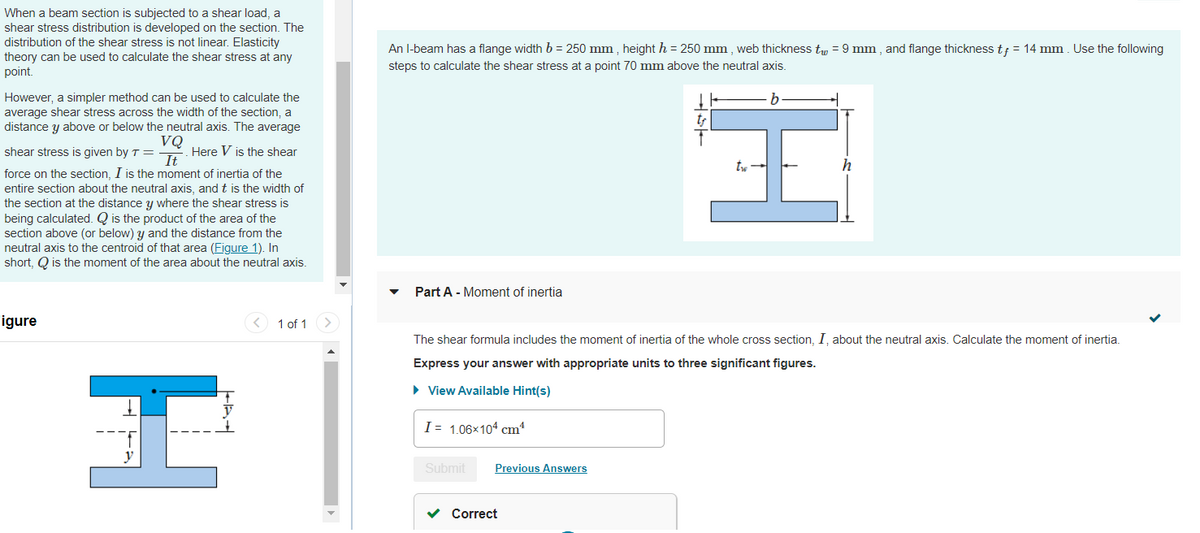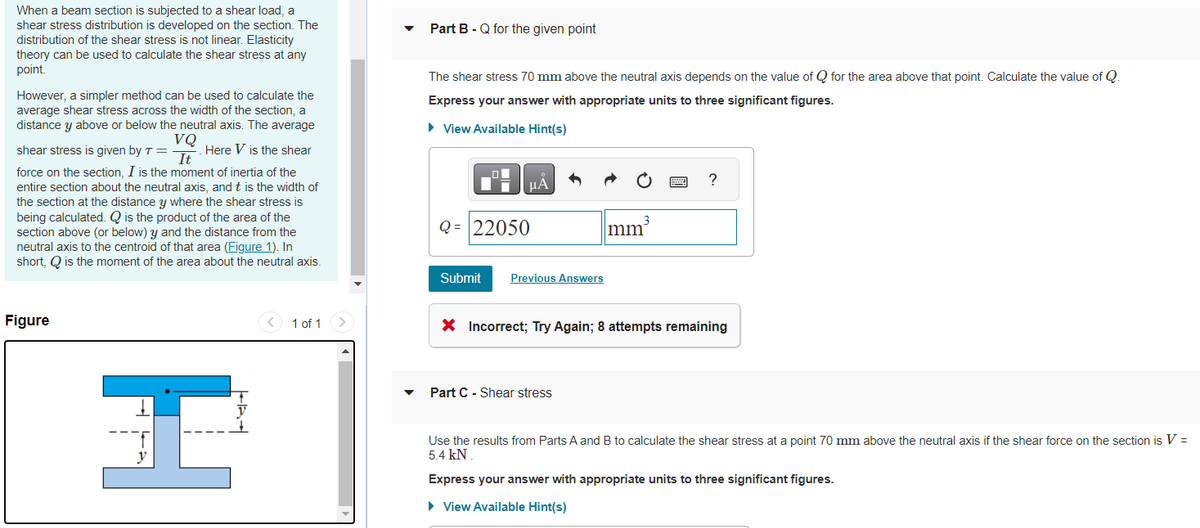subje shear stress distribution is developed on the section. The distribution of the shear stress is not linear. Elasticity theory can be used to calculate the shear stress at any point. However, a simpler method can be used to calculate the average shear stress across the width of the section, a distance y above or below the neutral axis. The average VQ shear stress is given by T = Here V is the shear It force on the section, I is the moment of inertia of the entire section about the neutral axis, and t is the width of the section at the distance y where the shear stress is being calculated. Q is the product of the area of the section above (or below) y and the distance from the neutral axis to the centroid of that area (Figure 1). In short, Q is the moment of the area about the neutral axis. I igure 1 of 1 > An I-beam has a flange width b = 250 mm, height h = 250 mm, web thickness t = 9 mm, and flange thickness tf = 14 mm. Use the following steps to calculate the shear stress at a point 70 mm above the neutral axis. Part A - Moment of inertia I= 1.06×104 cm¹ The shear formula includes the moment of inertia of the whole cross section, I, about the neutral axis. Calculate the moment of inertia. Express your answer with appropriate units to three significant figures. ► View Available Hint(s) Submit Previous Answers H ✓ Correct h
subje shear stress distribution is developed on the section. The distribution of the shear stress is not linear. Elasticity theory can be used to calculate the shear stress at any point. However, a simpler method can be used to calculate the average shear stress across the width of the section, a distance y above or below the neutral axis. The average VQ shear stress is given by T = Here V is the shear It force on the section, I is the moment of inertia of the entire section about the neutral axis, and t is the width of the section at the distance y where the shear stress is being calculated. Q is the product of the area of the section above (or below) y and the distance from the neutral axis to the centroid of that area (Figure 1). In short, Q is the moment of the area about the neutral axis. I igure 1 of 1 > An I-beam has a flange width b = 250 mm, height h = 250 mm, web thickness t = 9 mm, and flange thickness tf = 14 mm. Use the following steps to calculate the shear stress at a point 70 mm above the neutral axis. Part A - Moment of inertia I= 1.06×104 cm¹ The shear formula includes the moment of inertia of the whole cross section, I, about the neutral axis. Calculate the moment of inertia. Express your answer with appropriate units to three significant figures. ► View Available Hint(s) Submit Previous Answers H ✓ Correct h
Mechanics of Materials (MindTap Course List)
9th Edition
ISBN:9781337093347
Author:Barry J. Goodno, James M. Gere
Publisher:Barry J. Goodno, James M. Gere
Chapter5: Stresses In Beams (basic Topics)
Section: Chapter Questions
Problem 5.8.1P: The shear stresses t in a rectangular beam arc given by Eq. (5-43): in which Fis the shear force, /...
Related questions
Question

Transcribed Image Text:When a beam section is subjected to a shear load, a
shear stress distribution is developed on the section. The
distribution of the shear stress is not linear. Elasticity
theory can be used to calculate the shear stress at any
point.
However, a simpler method can be used to calculate the
average shear stress across the width of the section, a
distance y above or below the neutral axis. The average
VQ
shear stress is given by T =
Here V is the shear
It
force on the section, I is the moment of inertia of the
entire section about the neutral axis, and t is the width of
the section at the distance y where the shear stress is
being calculated. Q is the product of the area of the
section above (or below) y and the distance from the
neutral axis to the centroid of that area (Figure 1). In
short, Q is the moment of the area about the neutral axis.
I
Figure
1 of 1
An I-beam has a flange width b = 250 mm, height h = 250 mm, web thickness tw = 9 mm, and flange thickness tf = 14 mm. Use the following
steps to calculate the shear stress at a point 70 mm above the neutral axis.
Part A - Moment of inertia
The shear formula includes the moment of inertia of the whole cross section, I, about the neutral axis. Calculate the moment of inertia.
Express your answer with appropriate units to three significant figures.
► View Available Hint(s)
I= 1.06×104 cm¹
Submit Previous Answers
H
✓ Correct

Transcribed Image Text:When a beam section is subjected to a shear load, a
shear stress distribution is developed on the section. The
distribution of the shear stress is not linear. Elasticity
theory can be used to calculate the shear stress at any
point.
However, a simpler method can be used to calculate the
average shear stress across the width of the section, a
distance y above or below the neutral axis. The average
VQ
shear stress is given by T = Here V is the shear
It
force on the section, I is the moment of inertia of the
entire section about the neutral axis, and t is the width of
the section at the distance y where the shear stress is
being calculated. Q is the product of the area of the
section above (or below) y and the distance from the
neutral axis to the centroid of that area (Figure 1). In
short, Q is the moment of the area about the neutral axis.
Figure
H
1 of 1
Part B - Q for the given point
The shear stress 70 mm above the neutral axis depends on the value of Q for the area above that point. Calculate the value of Q.
Express your answer with appropriate units to three significant figures.
► View Available Hint(s)
LO
··
μA
Q = 22050
Submit Previous Answers
mm³
Part C - Shear stress
?
* Incorrect; Try Again; 8 attempts remaining
Use the results from Parts A and B to calculate the shear stress at a point 70 mm above the neutral axis if the shear force on the section is V =
5.4 kN
Express your answer with appropriate units to three significant figures.
► View Available Hint(s)
Expert Solution
This question has been solved!
Explore an expertly crafted, step-by-step solution for a thorough understanding of key concepts.
Step by step
Solved in 4 steps with 4 images

Knowledge Booster
Learn more about
Need a deep-dive on the concept behind this application? Look no further. Learn more about this topic, mechanical-engineering and related others by exploring similar questions and additional content below.Recommended textbooks for you

Mechanics of Materials (MindTap Course List)
Mechanical Engineering
ISBN:
9781337093347
Author:
Barry J. Goodno, James M. Gere
Publisher:
Cengage Learning

International Edition---engineering Mechanics: St…
Mechanical Engineering
ISBN:
9781305501607
Author:
Andrew Pytel And Jaan Kiusalaas
Publisher:
CENGAGE L

Mechanics of Materials (MindTap Course List)
Mechanical Engineering
ISBN:
9781337093347
Author:
Barry J. Goodno, James M. Gere
Publisher:
Cengage Learning

International Edition---engineering Mechanics: St…
Mechanical Engineering
ISBN:
9781305501607
Author:
Andrew Pytel And Jaan Kiusalaas
Publisher:
CENGAGE L